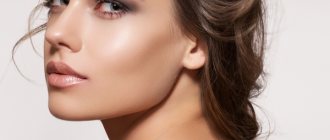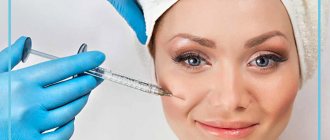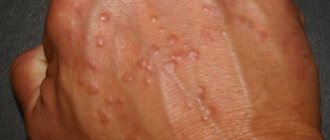Botox is a drug based on botulinum neurotoxin type A, which is produced by Allergan (USA). This word is also used to refer to all analogues of the drug. The botulinum toxin injection procedure gained popularity at the end of the last century and has since remained the most popular non-surgical anti-aging technique.
How does Botox work after injection?
Botox is a cosmetic drug that contains weakened botulinum toxin. This substance is produced during the life of the bacterium Clostridium botulinum. Scientists have learned to use the special properties of botulinum toxin in cosmetology practice, with the goal of radical rejuvenation of the face and neck.
Botox is administered through subcutaneous injections into the area where expression lines are concentrated - the most unpleasant primary sign of aging. Penetrating into the fibers of the facial muscle, botulinum toxin blocks the mechanism of neuromuscular transmission, causing inhibition of a particular muscular structure of the face. Why is this necessary? Unlike other muscles, the facial muscles are in close contact with the skin, ensuring its tension. When a muscle is exposed to a toxin, it completely relaxes, which leads to the smoothing of the skin attached to it. Visually, this is manifested by the complete smoothing of facial wrinkles and skin creases of varying depths, which transforms and rejuvenates the patient’s face.
As a result of such a radical effect, a person loses the ability to control the muscle. However, contrary to popular belief, the face does not look like an artificial mask at all, which is due to the selective technique of administering the drug. Simply put, the static nature of one individual muscle is completely unnoticeable against the background of active facial movements of the surrounding facial muscles. This is why Botox injections can only be done in a good clinic. Only an experienced cosmetologist will accurately select the area of injection of the drug to achieve the desired result. The doctor performing botulinum therapy must undergo special training and have good experience, otherwise the result may be disastrous.
Speaking about the mechanism of action of Botox after administration, one cannot fail to note the fact that botulinum toxin has temporary activity. In the process of metabolism and enzymatic reactions, the toxin is gradually eliminated from the body, weakening the effect on the muscles and returning the former facial expressions. This can be considered both a positive feature, because the patient does not have to worry about the irreversibility of the effect, and a negative one, due to the need to re-administer the drug to maintain the anti-aging effect.
Botulinum toxin: what is it and how does it help in the fight against wrinkles?
The effect of Botox is achieved due to the neurotoxin botulism type A. It is one of the most dangerous poisons in the world, but in cosmetology such microscopic doses of the substance are used that it is not at all difficult for a professional to control its effect and get a positive result.
Naturally, botulinum toxin is not used in cosmetology in its pure form. It is first stabilized and purified from protein impurities in the laboratory.
The effect of Botox is as follows: with an injection, it enters the muscle, blocking the transmission of nerve impulses in it. As a result, the muscle relaxes, its contraction stops, and as a result, the skin adjacent to it becomes smooth.
Where is Botox injected?
Botox injections are performed using ultra-thin needles, which avoids trauma to the skin and unsightly specific marks. The drug, as already mentioned, is injected into the area of localization of pronounced facial wrinkles.
- Forehead. Most often, injections are made in the frontal area, since Botox is effective in combating vertical wrinkles between the eyebrows, as well as smoothing deep horizontal frontal furrows;
- Eyes and lips. The introduction of Botox into the periorbital and perioral plane of the face will eliminate small expression wrinkles in the corners of the eyes and lips, which are popularly called “crow’s feet”;
- Neck area. Botulinum toxin therapy for the neck is rarely used, but with sufficient qualifications of the doctor, it can maximally correct age-related changes in the neck muscles;
- Nose. So-called “anger lines” on the bridge of the nose can also be corrected with botulinum injections.
Much less often, beauty injections are used to correct facial wrinkles in the lower third of the face, since in this case there is a risk of drooping (sagging) of the muscles that hold the facial contour. That is why the qualifications of the specialist who carries out this procedure are very important here.
Such injections do not cause discomfort to the patient himself, due to the fact that the skin is pre-treated with a local anesthetic solution. In the technique of botulinum injections, it is very important that the specialist correctly determines the area of injection of the drug, since the effectiveness of the procedure will ultimately depend on this factor. In order to eliminate the possibility of error, the doctor may ask the patient to grimace and twist during the procedure in order to determine the area where the largest number of facial folds of skin accumulate.
Indications and contraindications
- horizontal and vertical wrinkles in the forehead;
- correction of eyebrow shape;
- "crow's feet" around the eyes;
- wrinkles under the lower eyelid;
- pronounced nasolabial folds;
- drooping tip of the nose;
- purse-string wrinkles around the lips;
- drooping corners of the mouth;
- asymmetrical and gummy smile;
- hypertonicity of the masticatory muscles, bruxism;
- correction of facial oval;
- neck rejuvenation;
- hyperhidrosis (excessive sweating)
- pronounced facial asymmetry;
- neuritis (inflammatory disease of peripheral nerves);
- period of pregnancy and lactation;
- diabetes;
- skin tendency to form keloid scars;
- individual intolerance to the components of the drug.
Temporary contraindications to the Botox injection procedure:
- exacerbation of herpes and other infectious diseases;
- cold with accompanying fever;
- taking certain medications (antibiotics, antidepressants);
- inflammation of the skin (ulcers, carbuncles);
- upcoming climate change (travel to a country with a hot climate).
When does Botox start to work after injections?
Many patients, before this cosmetic procedure, are concerned about the question of how long it takes for Botox to work after introducing the drug under the skin. This topic is relevant for those clients of a cosmetologist who are sure that they can leave the clinic only when the effect of Botox appears. In fact, there is no immediate blockade of the neuromuscular motor impulse after administration of the drug. Typically, noticeable results gradually increase over 3-5 days after injections.
Today, the cosmetology market also offers a popular analogue of Botox – the French drug Dysport, which exhibits a pronounced effect already on the first day after the procedure.
At the same time, when Botox begins to act, it is not at all necessary to remain under the supervision of a doctor, since the effect can be gradually adjusted over three months, after the first use of botulinum therapy, and the most expressive final result can be achieved only after 2 weeks. After this period, it is recommended to undergo an examination with your cosmetologist. The doctor will evaluate the result and, if necessary, “fill in” the missing dose of the drug. Thus, your cosmetologist accurately selects your dose of Botox. It depends how long it takes for Botox to start working, primarily on the individual characteristics of the patient’s metabolism.
Is it possible to extend the result?
Follow all the cosmetologist's recommendations to get the maximum, safe and prolonged effect of the procedure.
We will consider the main recommendations below:
- Physical activity in the first 7-10 days after the session significantly reduces the effect of botulinum therapy.
- There are no additional jokes between the main courses! They will provoke the production of antibodies, which destroy the toxin and reduce its effect to a minimum.
- Avoid solariums, baths and saunas.
- Assess the compatibility of current pharmacotherapy with contraindications to botulinum therapy.
How long does the effect of Botox last?
How effective Botox is is perhaps one of the most frequently asked questions. Here it should be understood that there simply cannot be an unambiguous answer to this question, since the duration of local muscle relaxation will, like the speed of achieving the effect, directly depend on the metabolic functions of the body, more simply, on the metabolic rate. However, experts say that after the first administration of the drug, the average duration of action of Botox will be from 4 to 6 months.
Also, speaking about the duration of action of Botox, it is simply impossible not to mention the increased effectiveness of the drug with repeated administration. Repeated injections show a significantly longer lasting effect, which can range from 8 to 12 months. In addition, regular use of botulinum therapy often gives the cosmetologist the opportunity to reduce the dosage. This is largely explained by the fact that being stationary for a long time, the facial muscle loses the “habit” of actively moving, and a person loses the habit of “frowning,” which reduces the load on the facial muscles and the severity of wrinkles.
Repeated procedures
After Botox is removed, you can repeat the course to get the results back. Wait until your facial muscles have fully recovered to get the best results.
If Botox was administered for the first time, a corrective session is usually carried out after 8 months. All subsequent injections are performed at intervals of 4-6 months. With this technique you can maintain consistently good results.
If procedures are performed too often, the sensitivity of the dermis and nerve structures increases significantly. Botox dissolves faster each time, correction is required more often.
Is Botox harmful to health?
The question regarding the harms and benefits of Botox remains one of the most pressing for patients who have decided to undergo botulinum rejuvenation. The mechanism of action of the drug frankly frightens the majority of patients, who most often, as practice shows, fear paralytic effects on the surrounding muscles, distortions and drooping of facial muscles and other aesthetic problems. There is absolutely no need to worry about this, since the composition of botulinum preparations is absolutely safe and does not cause complications or side effects.
Such fears fuel unreliable Internet stories and myths about Botox, which, despite the drug being studied, continue to be passed on, as they say, “from generation to generation.” In fact, according to statistics, aesthetic harm from Botox occurs in only 0.14% of patients and is caused only by violations of the drug administration technique. Possible complications also include the following conditions:
- pain in the injection area occurs in 1.3% of patients;
- no more than 2% of people experience mild headaches;
- small hematomas at the injection site occur in 6% of patients only due to the fault of the specialist;
- temporary loss of sensitivity in the injection area is observed in less than 1% of cosmetologist’s clients;
- About 1% of the population is allergic to the drug;
- Infectious contamination of the injection site is extremely rare and is a consequence of non-compliance with the requirements of asepsis and antisepsis during the procedure.
All complications are exclusively temporary and disappear as botulinum toxin is removed from the patient’s body. When discussing unsuccessful botulinum therapy procedures, one cannot help but note that there is a small percentage of people (1-2%) who are resistant to the effects of this toxin and the procedure in this case does not allow achieving a rejuvenating effect.
Which Botox is better to inject?
The modern cosmetology market offers several drugs that contain botulinum toxin type A. The most popular, in addition to the world-famous American Botox, can also be considered the French drug Dysport. The main differences between these products are the dosage of botulinum toxin, as well as the speed of formation and duration of the final effect. An experienced cosmetologist will help you choose the most suitable drug for yourself, but most experts recommend giving preference to the classic American Botox from the Allergen company, due to the greater knowledge of this product.
At what age can Botox be injected?
Manufacturers do not indicate clear restrictions on the age group, however, most specialists do not work with patients under 18 years of age. Moreover, at such a young age, there are most often no clear indications for such radical anti-aging therapy. The only exceptions are individuals who have a genetic predisposition to the formation of facial wrinkles. Many people mistakenly believe that this phenomenon is associated with overly active facial expressions, but in fact this factor is of secondary importance, after heredity.
When answering the classic question, at what age can Botox be injected, most experts still determine the age group from 30 to 45 years, when the drug will demonstrate the most pronounced effectiveness. At the same time, for elderly patients over 60 years of age, the relevance of Botox is lost every year, due to the manifestations of age-related tissue ptosis, which is noticeable even when the muscle is in a relaxed state.
Can Botox be done during pregnancy?
The use of Botox during pregnancy has not been sufficiently studied to date, so it is better to avoid this procedure while pregnant. At the same time, Botox is not contraindicated when planning pregnancy, since this procedure does not have a systemic effect on the woman’s body.
If, however, beauty injections were given at a time when the woman was not yet aware of her interesting situation, there is no reason to panic. The vast majority of the fair sex, who decided to take care of their beauty during this difficult period, did not notice any side effects or complications during pregnancy. As for the question of whether Botox can be injected while breastfeeding, there can be no restrictions here, since the drug does not pass into the milk of a nursing woman.










